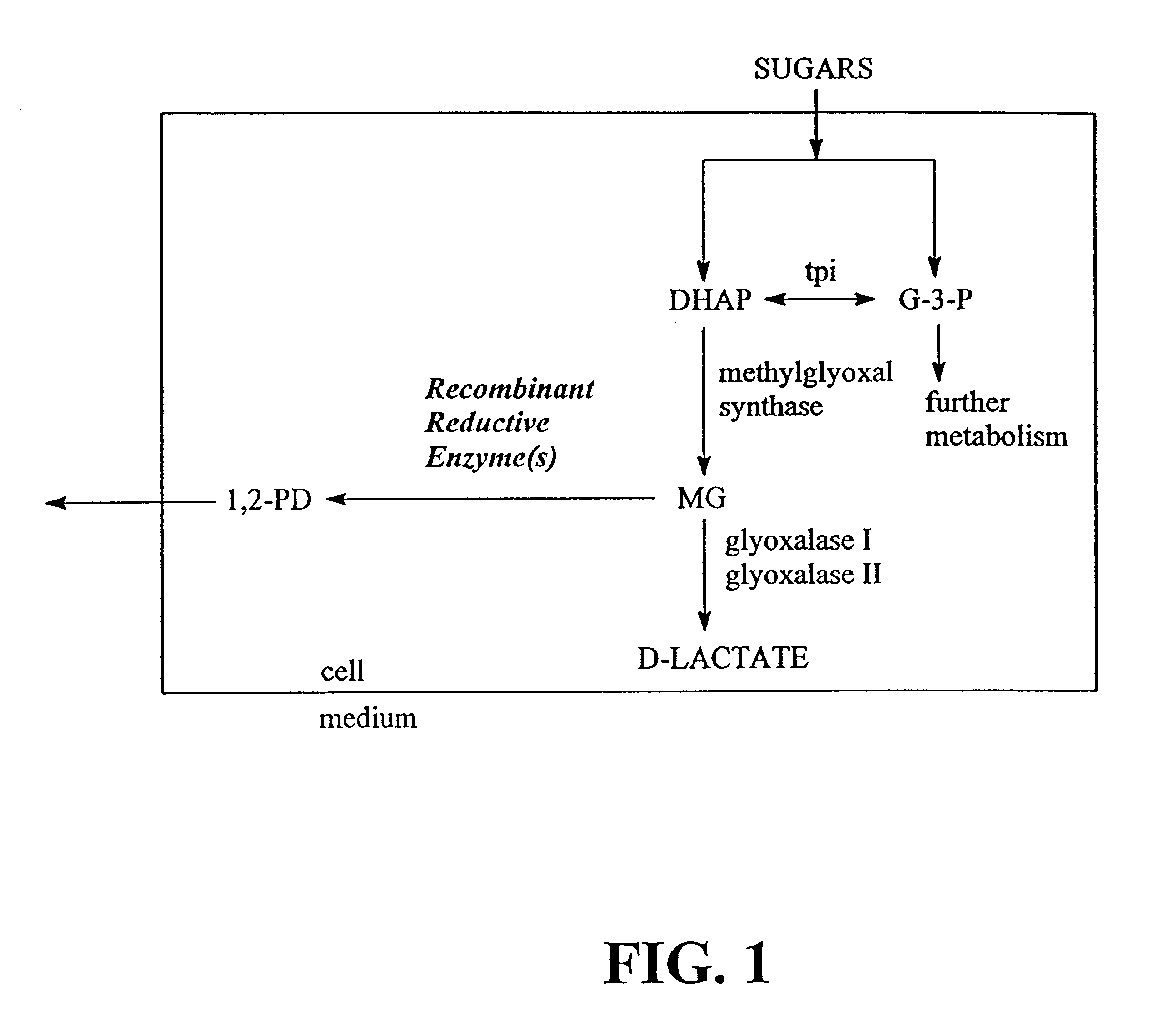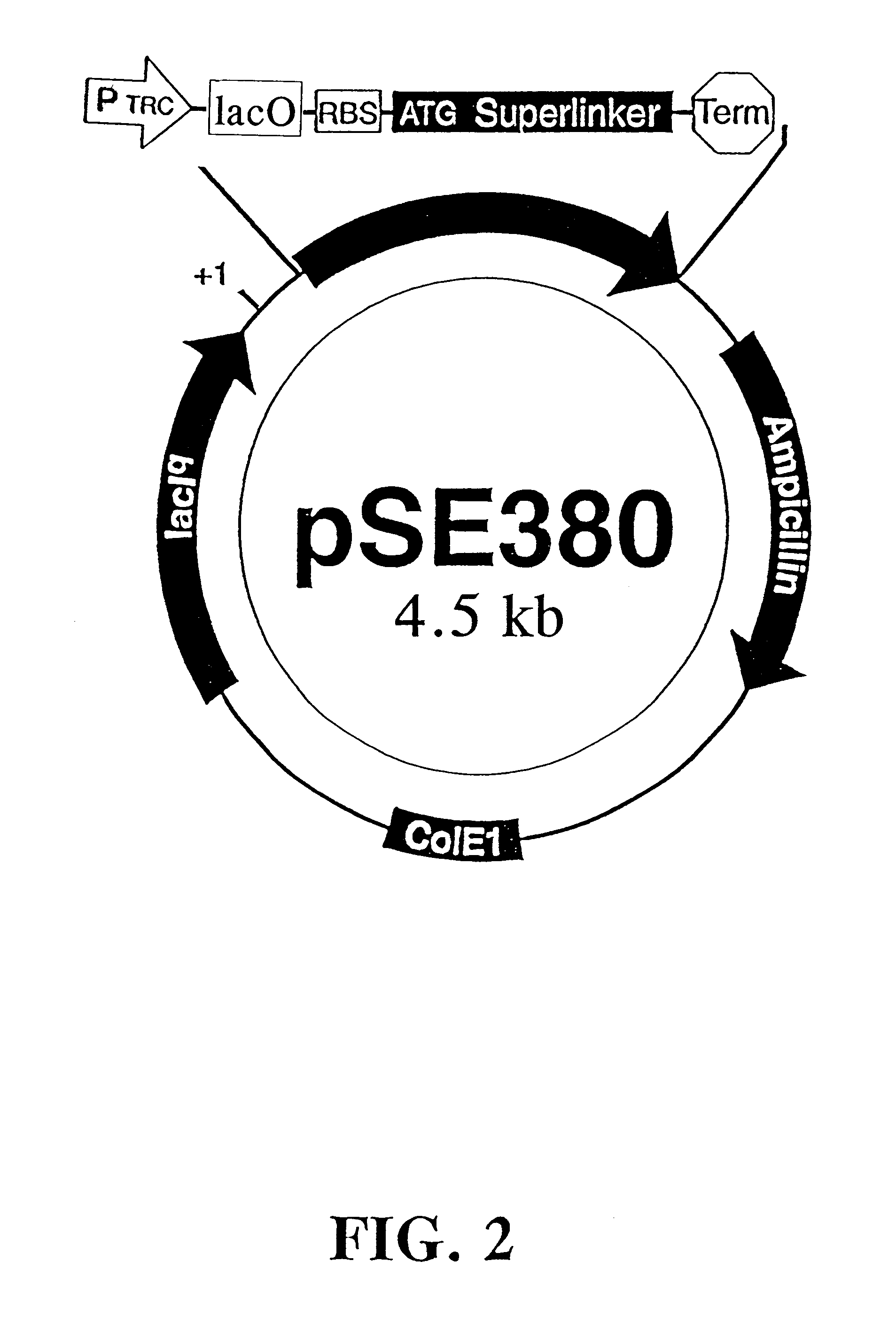Microbial production of 1,2-propanediol from sugar
a technology of 1,2-propanediol and sugar, which is applied in the field of 1,2-propanediol production, can solve the problems of large water consumption, inability to commercialize, and inability to reduce the production of polyglycols, and achieves low toxicity to microorganisms, low cost, and renewable resources.
- Summary
- Abstract
- Description
- Claims
- Application Information
AI Technical Summary
Benefits of technology
Problems solved by technology
Method used
Image
Examples
example 1
Chromatographic Analysis of Culture Broth
FIGS. 3 and 5 depict HPLC analyses of the culture broth of an E. coli strain AG1 transformed to express aldose reductase (using pKKARX) and a non-transformed culture of the same strain, respectively. FIG. 4 depicts an HPLC elution profile of a 1,2-PD standard solution. With reference to FIG. 3 and 5, the fermentations were performed under standard anaerobic conditions using 5 g / L glucose as carbon source. Media samples were centrifuged and filtered before analysis.
To generate the plots shown in FIGS. 3 and 5, an organic acids column (Bio-Rad "HPX87H", Hercules, Calif.) was used to quantify 1,2-PD, ethanol, sugars, and organic acids under the following conditions: 50 .mu.L sample size, pH 2 (H.sub.2 SO.sub.4);, 0.5 mL / min flow rate, and 40.degree. C. column temperature. Peaks were detected by a refractive index detector at 40.degree. C.
The 1,2-PD peak from the organic acids column was further analyzed by injection onto a cation-exchange column...
example 2
Production of 1,2-Propanediol from Various Common Sugars
In this Example, a triose phosphate isomerase mutant (tpi-), AA200, was transformed with pSEARX containing the gene for aldose reductase as described above. (This transformed cell line is designated AA200::pSEARX). The non-transformed AA200 mutant yields higher intracellular concentrations of methylglyoxal, the precursor to 1,2-PD, than the wild-type. (See Hopper and Cooper (1972).) When transformed with pSEARX, the AA200::pSEARX cell line produced 1,2-PD from arabinose, galactose, glucose, lactose, sucrose, and xylose. The yield of 1,2-PD from AA200::pSEARX fermented with various sugars was as follows:
Fermentation was performed using standard anaerobic fermentation procedures using 10 g / L of the appropriate sugar. The fermentation was allowed to proceed for 24 hours prior to analysis for 1,2-PD.
example 3
Inducible Production of 1,2-PD
In this Example, the results of which are depicted in FIG. 6, E. coli strain AG1 was transformed as described herein with the pSEARX plasmid containing the aldose reductase gene. The transformed cells were then cultured under standard anaerobic conditions on 5 g / L glucose with increasing levels of the promoter IPTG. The X-axis of FIG. 6 gives the concentration of IPTG in millimolarity. The right-hand Y-axis (.box-solid.) reports the production of 1,2-PD in mg / L as a function of IPTG concentration. Likewise the left-hand Y-axis (.circle-solid.) reports the activity of aldose reductase in U / mg. As is clearly shown in FIG. 6, inducing the promoter leads to the production of 1,2-PD.
PUM
| Property | Measurement | Unit |
|---|---|---|
| temperature | aaaaa | aaaaa |
| pH | aaaaa | aaaaa |
| column temperature | aaaaa | aaaaa |
Abstract
Description
Claims
Application Information
 Login to View More
Login to View More - R&D
- Intellectual Property
- Life Sciences
- Materials
- Tech Scout
- Unparalleled Data Quality
- Higher Quality Content
- 60% Fewer Hallucinations
Browse by: Latest US Patents, China's latest patents, Technical Efficacy Thesaurus, Application Domain, Technology Topic, Popular Technical Reports.
© 2025 PatSnap. All rights reserved.Legal|Privacy policy|Modern Slavery Act Transparency Statement|Sitemap|About US| Contact US: help@patsnap.com



